Key Cold Email Mistakes to Avoid in Your Cold Emails
A cold email is a way to make a connection with the person who does not know you yet. A cold email can be both your friend and your foe. It can either open up a world of opportunities for you or damage your reputation irrevocably. When done right, cold emailing can be your instrument for getting new contacts or leads, for finding a mentor, business partners, or investors. It can help you land the job of your dreams or close the deal of your life. when done wrong, it can be a very costly mistake to pay for.
The benefits of cold emails
Marketers, entrepreneurs, journalists, and many other professionals in different areas write cold emails. While some might doubt cold emailing efficiency, it is at times the best way to expand your contacts, bring in new clients, or simply broaden your professional network. If you have considered writing this type of emails, you should definitely give it a try.
Here are some benefits of cold emails that show why sending those might be a good idea for you.

Before sending your cold mail, make sure you are doing it right. First of all, put yourself in the recipient’s shoes. Will you want to open an email from a stranger? Why? What will persuade you to do that? What will you want to see in it? What will make you respond or take an action?
While you are thinking on the answers and sketching your first cold message, let’s see the 20 most common cold email mistakes. Be sure to not repeat those yourself.
Key cold email mistakes people make
1. Sending your cold email to a wrong person
That’s the first cold email mistake you should avoid. Writing to the wrong person or organization will make your email look like spam (and eventually marked as one). It can nullify all your efforts at once and harm your reputation.
One of the best cold email tips would be: Send the right message to the right people at the right time. Choose your prospects wisely, select those who are likely to benefit from knowing about you. Research them carefully. Don’t target everyone; target the people in your niche instead. Target decision makers and those who will really find you helpful.
2. Using unclear subject lines
Do not use vague or weak subject lines because they affect how people will react. According to HubSpot, 33% of recipients will open emails only because of the subject line. So don’t make them too sales-y and avoid the spam triggers. Don’t make the subject line too vague, keep them to the point. Give your prospect a reason to read it.
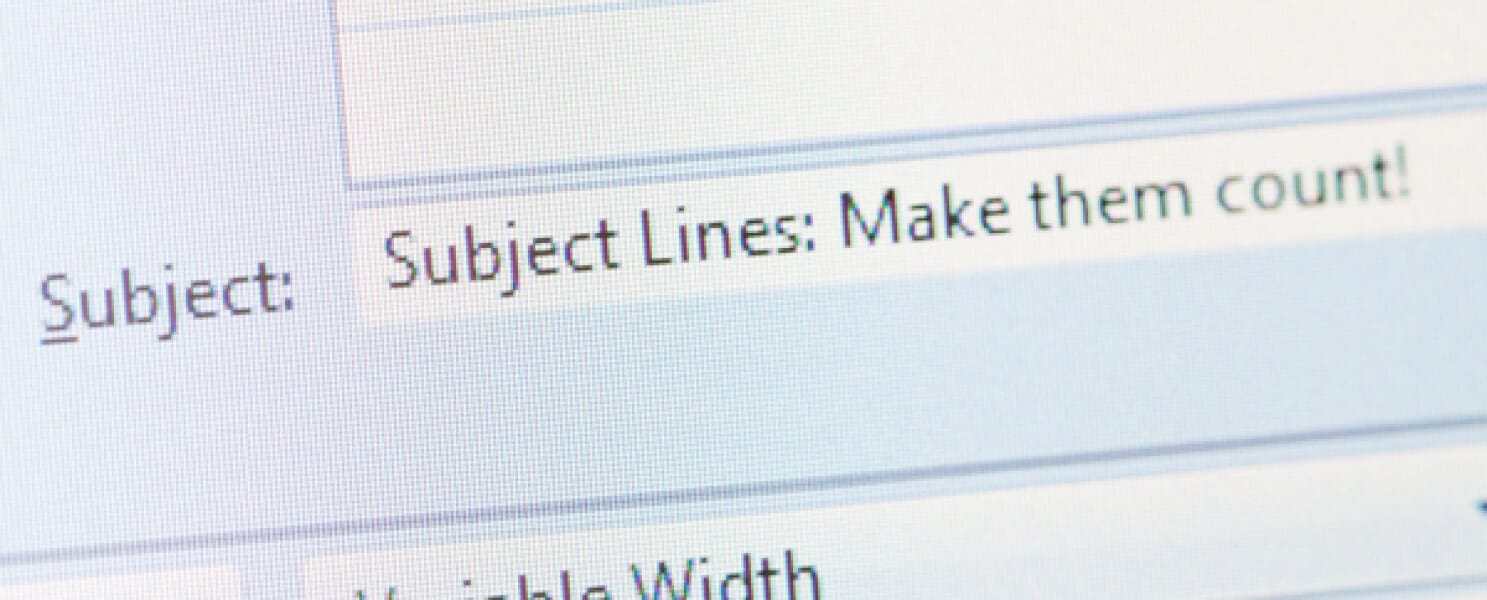
3. Forgetting to replace template details
No way should you send out a template. Make sure you addressing a particular person by name and that you have all their details correct. Always double check what you are sending.
4. Sending generic messages
No matter how perfect your subject line is, you will get no response or reaction when your message sounds generic. Remember that you writing to a real person, so make it look human and authentic. Write it as if you were actually talking to your prospect.
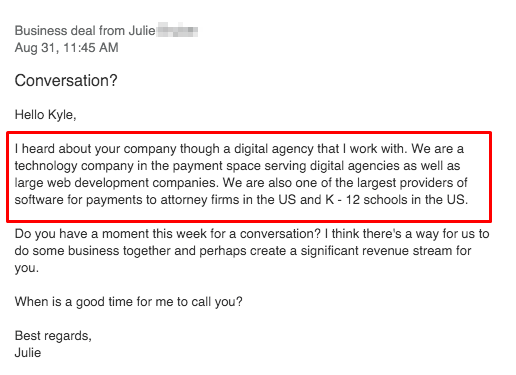
5. Not segmenting and customizing your template
Do not write the same message to everyone. You should focus on quality rather than quantity. It takes some time to tailor an email to each of your prospects, but it will reward you at the end. So use the person’s name, mention something you know about them, and provide some common ground. Show them you are aware of their needs and that you are here to help them in particular.
6. Writing too long emails
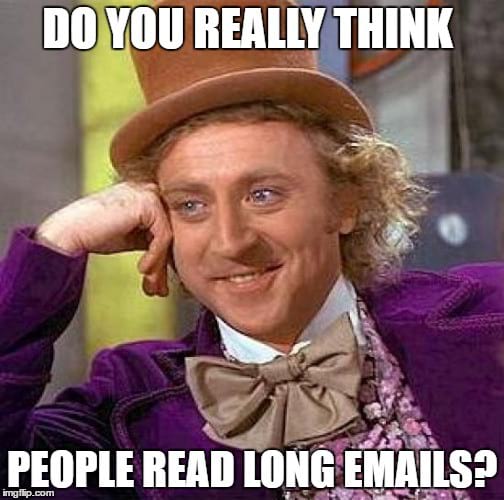
Never write a long cold mail piece. Your task is not to give extensive information about yourself, but merely to get the attention and spark some interest. You will have a chance to tell your story once the person writes you back. If they choose you to. So try to wrap it up to 3–5 sentences.
7. Writing too long sentences
Also, do not write overly long sentences. Make your email readable and easily digestible. Do not bore your prospect with unnecessary details or fancy words.
8. Babbling in your cold email
Do not ramble. Stick to the point. Provide your prospect with a reason you are writing and ask them to take an action. Be clear and concise.
9. Not talking about them
Do not brag about yourself or your business in your cold emailing sequences. You are here for the person you are writing to. If you know their problem, refer to it. Recognize their needs and suggest a solution. Be there at the right moment, and it will work in your favor.
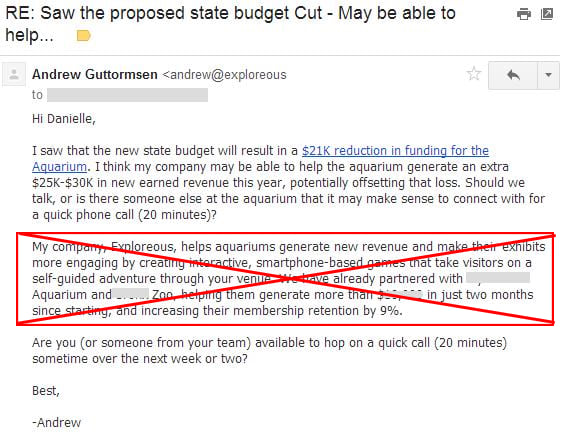
10. Talking about you
Don’t talk about yourself. It is another common mistake in cold emails. You can even skip the introduction altogether. Your prospects generally do not care about you and your company, they allow your message in their inbox because you might have what they need.
When crafting your cold message, stick to this one rule: It’s not about you, it’s about them. You are trying to solve their problems and appeal to their needs.
11. Overdoing with self-praising
Do not list your advantages or tell how cool your business is in every single email or follow-up. If necessary, mention how your recipient can benefit from you, and that’s all. If needed, let others speak for you. It can be testimonials on your website or nice words about you from a mutual connection. Being humble works best.
12. Turning your cold email to "marketing talk"
Leave your marketing pitch for your ads. Avoid fancy words and loud claims starting from the first email. Instead, try to sound human and authentic. You are addressing a real person here, not a faceless audience of millions.
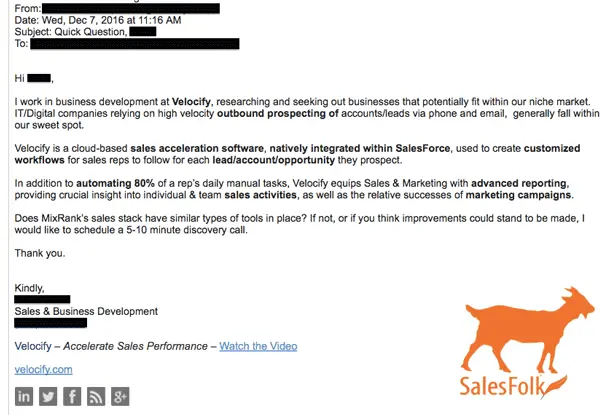
13. Not including benefits
Instead of telling about your awesomeness, focus on how you can be useful to your prospect. How can he or she benefit from you? What will they get in return for a reply to your message? Why should they care in the first place?

14. Not including CTA
Remember about being clear and concise in your message? Well, make sure you include a specific call to action in your email, the one you are expecting your prospect to take. It can be a direct response with an answer to your question, a meeting, or information exchange. The trick is to stick to just one CTA.
15. Not double-checking your grammar
There is no excuse for bad grammar. If your message is not grammatically correct, it means only that you didn’t bother enough to double-check it or turn your spell-check on. If you are still not sure, give your email for a proofread to an editor. Better safe than sorry.

16. Using jargon in your cold email
Being authentic and conversational does not mean that you should use professional jargon the way you normally do. Bear in mind that not everyone can understand it, especially when they are not in your field. Besides, that might make your recipient feel incompetent, and you surely don’t want this.
17. Not showing credibility
Here is general advice: do not write to your prospects before you establish your online presence. Let them have an opportunity to check you on their own. Make sure your business has a website with good comprehensive content and social profiles. Including a few testimonials from other people in your niche will be also helpful.
18. Not using an email signature
Another thing that gives you credibility is your custom email signature. Write your full name and your contact details, add your email address. Include a photo of yourself to make your cold email look more personal or a company logo to make it look recognizable. No signature often means no trust in your email outreach.
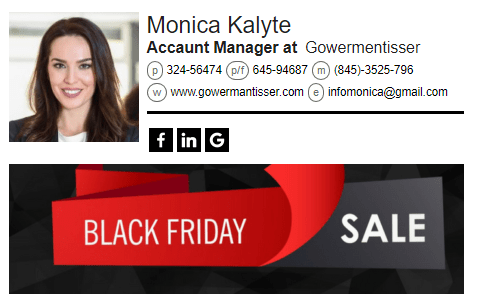
19. Not including people you mention in CC/BCC
If someone referred you and you are mentioning this, include this person in your email copy. It is not just an ethical thing to do, but a great way to gain more credibility. And vice versa, don’t forget to specify in the message why you are CC-ing it to that other person.
20. Not following up
Not following up with people makes them forget about you easily. A nice follow-up email, on the other hand, reminds of you and your email. What’s more, it makes your message a little more personal. When a person receives a cold email, they might disregard it as yet another piece of digital junk. By sending a custom-tailored follow-up, you highlight their importance to you. All in all, around 85% of your leads are likely to be generated through follow-ups with people you’ve cold-emailed previously (LeadFuze).
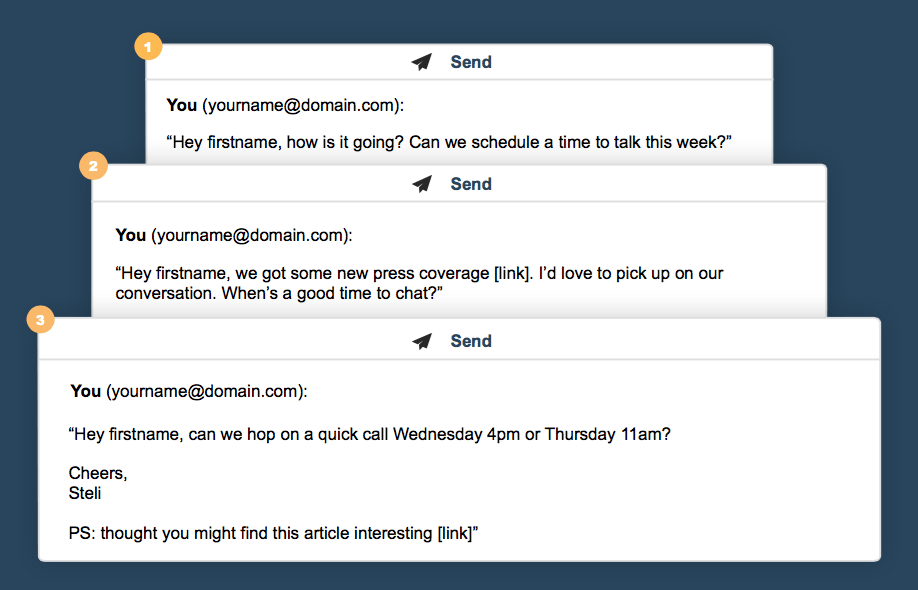
Summary
As said above, a cold email can be a powerful tool to get new quality leads, establish contacts, or form lasting business relationships. It is a great way to reach out to people who potentially like you, but do not know you yet. And precisely because this instrument is so powerful, it can work both ways. It can as easily damage your good name and avert people from you.
Your task is to make your cold email stand out and spark interest in your prospects. There are some tips for sending cold emails: they should be authentic and personal, focused around a particular recipient and tailored to their specific needs. Such an email should be also humble, brief, straight to the point, and grammatically flawless.
If you took all the measures and did not get a reply still, don’t give up: try following up with the prospect. Then reiterate it. And once again. And if it doesn’t work, just move on. Maybe this person is really not interested in what you have to say.



